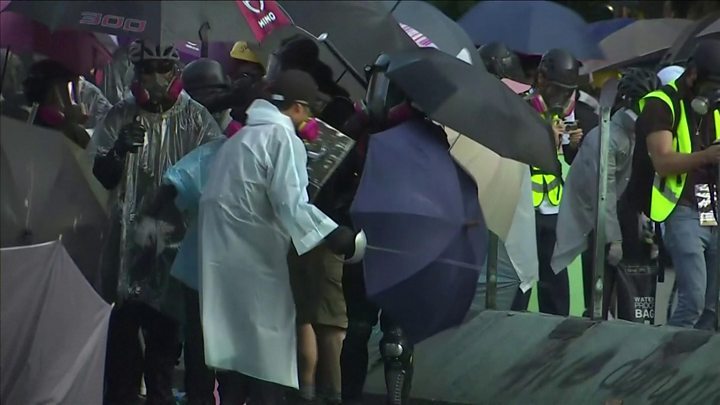[ad_1]

Media playback is unsupported on your device
Protesters occupying a university in Hong Kong have been firing arrows and launching petrol bombs at police as they seek to keep control of the barricaded campus.
A media liaison officer was wounded in the leg with an arrow near the Polytechnic University (PolyU).
Police have warned that that they could use live ammunition if protesters do not stop attacking officers.
Months of anti-government protests have caused turmoil in the city.
Police have so far been responding to violence around the PolyU campus mostly with tear gas, rubber bullets and water cannon.
Those occupying the university have been told to leave immediately. Dozens have reportedly been arrested but hundreds remain barricaded inside.
There are fears of bloodshed should police move in to quell what they have now declared a riot.
Image copyright
AFP
The officer was struck in the leg close to the Hong Kong Polytechnic University
Earlier on Sunday police fired a live round in response to what they said was a car driving towards officers near the university.
Protests in Hong Kong
The protests in Hong Kong, which began in June, were triggered by a now-withdrawn plan to allow extradition to mainland China but have since expanded into wider demands for greater democracy and for investigations into the actions of police.
The government recently confirmed the city had entered its first recession for a decade.
In recent days, Hong Kong’s university campuses have been the scenes of pitched battles between police and demonstrators.
On Sunday, riot police fired tear gas and used water cannon against protesters at the PolyU, who launched bricks and petrol bombs at them. Protesters took cover behind umbrellas on a footbridge and set light to debris there, causing a huge fire.
The blaze triggered a number of small explosions, witnesses said, and fire crews eventually moved in to douse the flames.
There have also been heavy clashes on a bridge above the Cross Harbour tunnel, which links Kowloon and Hong Kong island.
A police truck on the bridge was set on fire and forced to retreat.
Image copyright
Getty Images
Protesters have been holding a bridge above the Cross Harbour tunnel
Image copyright
Reuters
A footbridge near the university was set alight
Pro-democracy lawmakers are trying to enter the campus to communicate with those inside, the South China Morning Post newspaper reports.
A reporter with the Reuters news agency at the campus says there are “grave fears of a bloody showdown”.
In a statement the university urged those occupying the campus to leave ..
“Universities are venues for advancing knowledge and nurturing talents. Universities are not battlegrounds for political disputes and should not be drawn into violent confrontations,” it read.
Image copyright
AFP
Protesters armed with bows and arrows have been seen on the PolyU campus
Police said the wounded officer had been on duty near the PolyU when he was hit by the arrow on Sunday afternoon.
“Such acts are life-threatening to everyone on the scene,” a statement on Facebook said.
“The force strongly condemns the violent acts of rioters and is carrying out its dispersal and arrest actions now. We call on citizens not to head towards the PolyU area as the situation is sharply deteriorating.”
On Saturday, Chinese soldiers in shorts and T-shirts took to the streets to help clean up debris and remove barricades. It was the first time since the protests erupted that Chinese soldiers, who very rarely leave their barracks in Hong Kong, had taken to the streets.

Media playback is unsupported on your device
Why are there protests?
Hong Kong – a British colony until 1997 – is part of China under a model known as “one country, two systems”.
Under this model, Hong Kong has a high degree of autonomy and people have freedoms unseen in mainland China.

Media playback is unsupported on your device
The protests started in June after the government planned to pass a bill that would allow suspects to be extradited to mainland China.
Many feared this bill would undermine the city’s freedoms and judicial independence.
The bill was eventually withdrawn but the protests continued, having evolved into a broader revolt against the police, and the way Hong Kong is administered by Beijing.
[ad_2]
Source link

